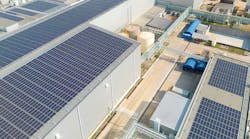Cold storage buildings, where life-saving vaccines are manufactured and stored, are required to maintain frozen temperatures — much colder than a typical building. But a roof assembly — when properly designed and constructed — can play a critical role in maintaining these temperature requirements, while providing other benefits as well.
Here are three ways roof design and installation can impact operations and energy usage at pharma manufacturing and storage facilities.
Protection of stored goods
Two roof surface temperatures, differing only by color, can vary by as much as 60 degrees Fahrenheit in the summer heat. Dark colored roofs can reach up to 150 degrees Fahrenheit, whereas white or reflective roofing colors can have significantly lower surface temperatures. These temperatures often radiate into the building below, raising the interior temperatures, which are essential to maintain in pharmaceutical storage.
Roof insulation, which is an integral component of the roof assembly, further separates the exterior heat from the interior cold temperatures. Proper roof design, including the selection of membranes that reflect the sun’s rays and the appropriate use of insulation in the roof assembly, can help protect the pharmaceutical products being stored inside, by maintaining interior temperature set points.
Improved operations
In 2020, the pharmaceutical manufacturing industry had an average of 1.6 recordable cases of nonfatal occupational injuries per 100 workers — only slightly below the average of 1.9 cases across all industries, according to the U.S. Bureau of Labor Statistics.
Unsafe interior conditions, including ice accumulation on the facility floor, can occur when warm air enters the building through an improperly designed or installed roofing system. Warm air often enters through roof penetrations or at roof perimeters where the roof-to-wall intersection may have breaches in materials. Warm, and most perilous, warm humid air, will mix with the cold interior air and condense. The condensation generally settles on cold surfaces, such as the manufacturing or storage floor, and due to the cold interior temperatures, the condensation may turn to ice. When ice forms on the floors, it can cause slips, trips or falls for occupants, and can also impact operations if a particular area of the facility has to be avoided.
Reduction of energy use
The effectiveness of roof insulation is determined by its R-value, which is a measure of thermal resistance. The higher the R-value, the better the thermal performance of the insulation and its effectiveness at maintaining interior temperatures. Up to 29% of the R-value of roof insulation is lost through fastener penetrations that occur through the roof assembly.
Selection of the roofing attachment method during installation can add significant energy savings over the lifetime of the roof system, which is typically 25 to 35 years.
The fasteners used to attach insulation boards and single-ply membranes (the most common roof membrane type) act as thermal bridges, allowing for air and thermal movement, so that the design R-value is reduced. When fasteners are used to attach the insulation and the membrane to the roof deck, it is referred to as a mechanically attached system. A way to reduce the thermal bridging, and effective energy loss, that occurs at fastener penetrations is to bury them within the layers of insulation or to eliminate them altogether and install an adhered roof system.
Properly designed and installed roof assemblies can help reduce air and thermal leakage, which may reduce loads on HVAC systems required to maintain interior temperatures. Reduced loads on HVAC systems can reduce cooling costs as HVAC systems will have decreased run times.
Although a roofing system covers the entirety of a facility, we often don’t stop to look up and realize the impact it can have on our overall operations and bottom line. But not only can a roof assembly protect the efficacy of products being stored inside — it can also help reduce energy use over the life of the pharma facility.




